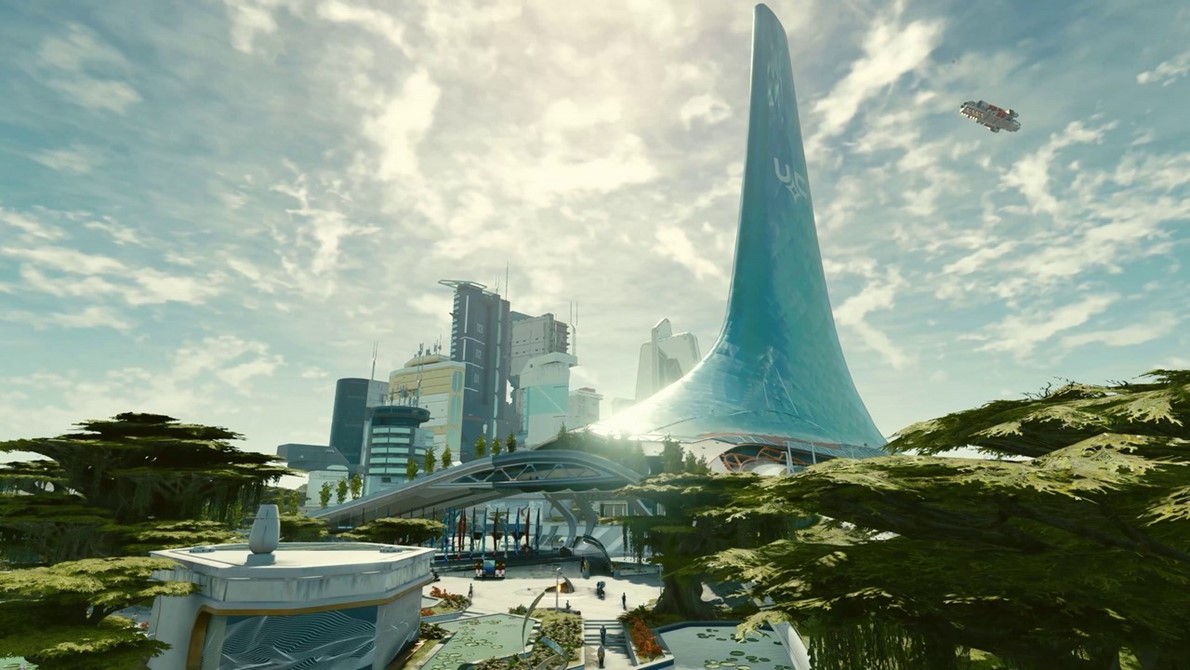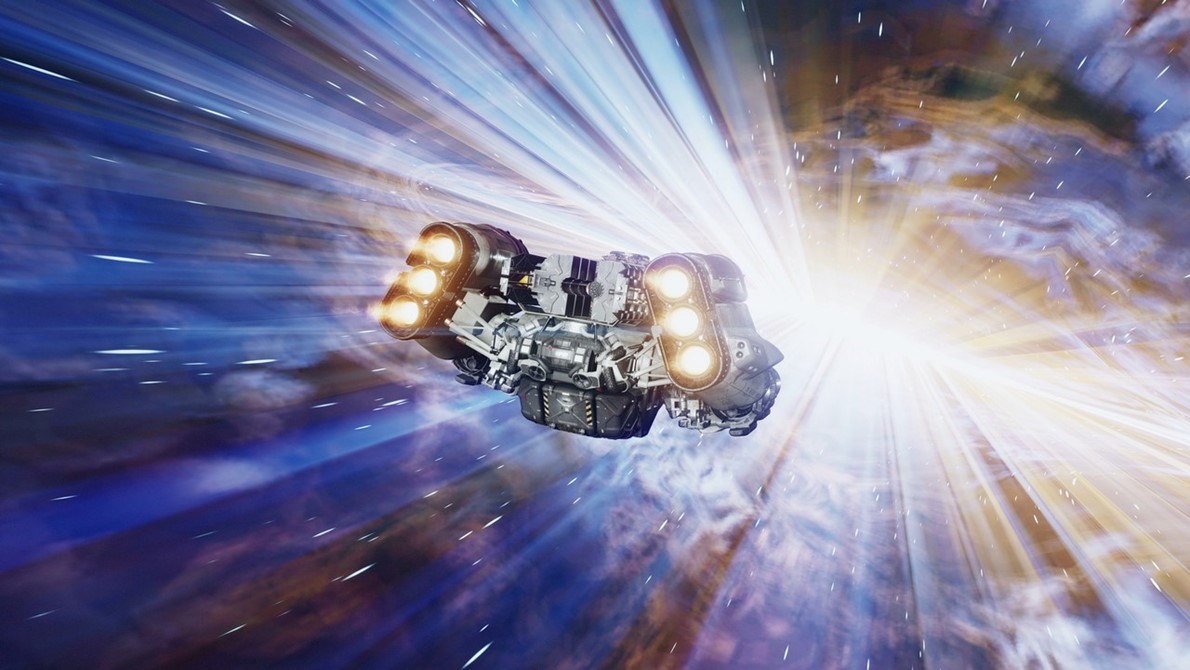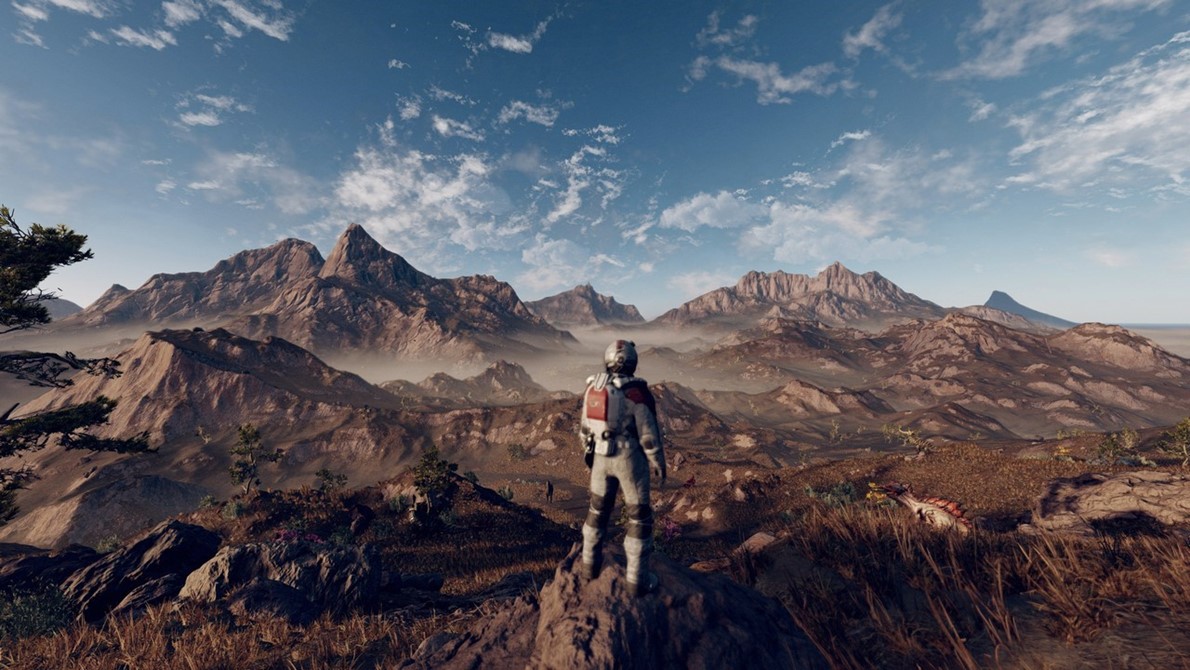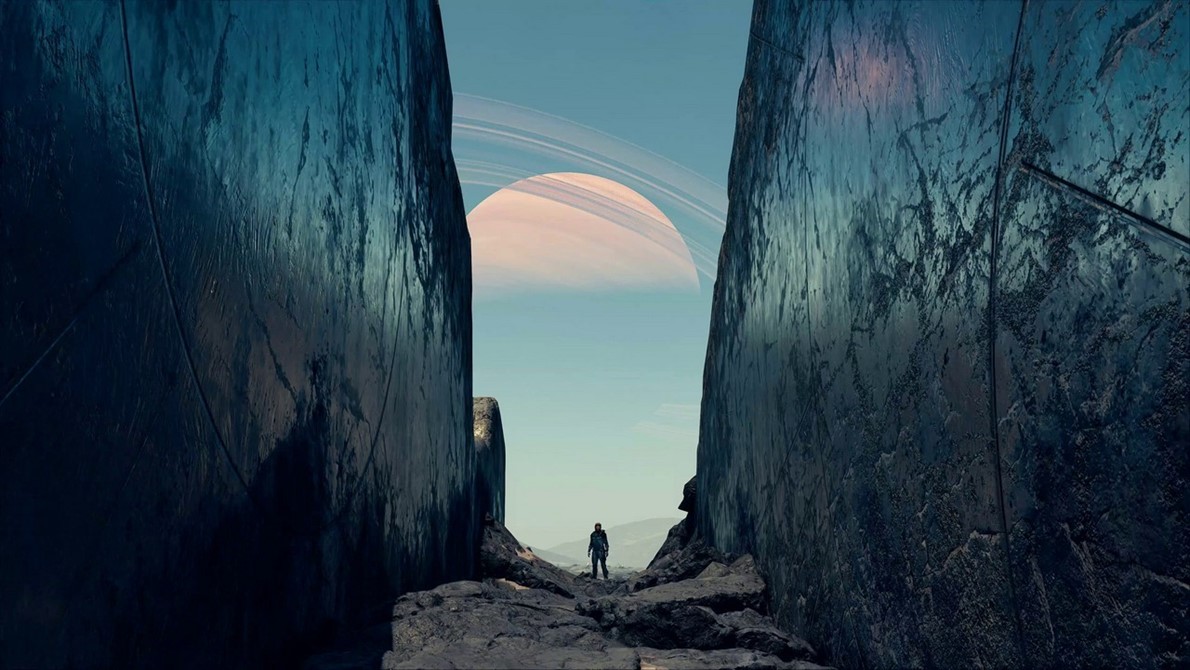Starfield’s 1,000 planets may be one giant leap for game design
Kellen Browning and Matt Stevens, New York Times
last updated: Sep 03,2023

Starfield almost immediately nudges its players to the edges
of the cosmos. In the opening hours of the role-playing video game, it’s
possible to land your spaceship on Earth’s moon or zip 16 light-years to Alpha
Centauri. When you open your map and zoom out from a planet, you can behold its
surrounding solar system; zoom out again, and you’re scrolling past luminous
stars and the mysterious worlds that orbit them.اضافة اعلان
That sprawling celestial journey within Starfield, developed by Bethesda Game Studios, reveals both the tremendous potential and the monumental challenge of an open-world space adventure. Bethesda has hyped an expansive single-player campaign with 1,000 explorable planets. And expectations around the game, officially releasing September 6 after a 10-month delay, are nearly as vast.

It’s the first new universe in 25 years for Bethesda, known for the Elder Scrolls and Fallout series. It’s also a high-stakes moment for Microsoft, which makes the Xbox and has long faced criticism that it produces fewer hit games than its console rivals, Sony and Nintendo. To compete, Microsoft went on a spending spree, acquiring Bethesda’s parent company in 2020 and agreeing to purchase Activision Blizzard in 2022, a $69 billion bet that is being challenged by regulators.
Now Bethesda must deliver. Known for letting players navigate competing factions and undertake eccentric quests, the studio hopes Starfield will dazzle those clamoring for engaging encounters with alien life-forms or space mercenaries as well as a sense of boundless exploration.
But creating a game the size of a galaxy is extraordinarily time-consuming and expensive, and several past attempts that shot for the stars failed to stick the landing.
“The biggest challenge you face when building any sci-fi game is the almost limitless imagination as players we have about space and about the universe,” said Aaryn Flynn, the CEO of Inflexion Games and a former general manager of BioWare, which makes the sci-fi Mass Effect series. “Players want that captured in the experience.”
Todd Howard, the executive producer of Bethesda, was well aware that Starfield, which is being released for Windows computers and the Xbox Series X and S, would have to be expansive to reflect the allure of space travel.
“All of us, I think, at some point look to the sky and say, ‘Man, I wonder what it would be like to blast off and land on the moon?’ or, ‘I wonder what would be beyond that?’ or, ‘What’s in that star?’ or, ‘Is there life out there?’” Howard said in an interview, adding, “We needed the scale to have that feeling. We could have made a game where there are four cities and four planets. But that would not have the same feeling of being this explorer.”
So Starfield has promised 1,000 searchable planets, about 10 percent of which contain life in addition to quests and valuable raw materials. That scale has caused some concern that the studio responsible for glitchy releases like Skyrim and Fallout 76 is in over its head — and that some aspects of space will be a black hole of fun.
The game’s developers say they are confident they have struck the right balance by using a mix of scientific data and artificial intelligence to generate realistic planets, then fine-tuning those worlds with human programmers who also craft the quests and the enemies that players will encounter.

“We have artists who hand-built the rocks, partly from scanning real rocks in our world and changing them,” Howard said. “And then we have algorithms that create the landscape of a planet and put the rocks and the trees in all the right places.”
When players land on a new planet in Starfield, they may encounter a tangle of atlas weed or discover that giant crabs can viciously attack. Those who enjoy hoarding can pick up items as innocuous as a jar of sealant in an abandoned laboratory.
But exactly how the game unfolds will differ for each player. Howard acknowledged that Starfield posed “an incredibly difficult design challenge” — one his team tried to solve by building a planet content manager that allows certain quests to be placed as players reach the surface. One player might run into a derelict outpost; someone else might hear another spaceship’s engine as she wanders. Developers have also tried to ensure that very little will happen in some cases so that players “get some periods of loneliness,” Howard said.
Despite the technological advancements that have made it possible to generate countless planets with ease, more than a dozen gaming executives, analysts and developers said in interviews that studios must be wary of overpromising what they can deliver.
No Man’s Sky drew incredible hype when its developers at Hello Games spoke of a procedurally generated universe of no fewer than 18 quintillion planets. But when the game made its debut in 2016, players found its worlds uninteresting and its alien dinosaurs crude. The criticism was so harsh that one of the company’s founders said he received death threats; the independent studio was investigated for false advertising and eventually cleared.
“Procedural generation can generate new maps but not compelling gameplay,” said Elena Bertozzi, a professor of game design and development at Quinnipiac University. “No Man’s Sky had a lot of planets with nothing interesting going on.”

A spokesperson for Hello Games declined to comment, referring to public remarks that one of its founders, Sean Murray, made in 2019. By then, the game had improved and was being praised for its successful postrelease updates.
“Innovation is in such short supply in the industry, and we need it so badly,” Murray said at the time. “We need to encourage it; we need to foster it. We need to ask people to shoot for the moon. And if they fail on their first attempt, we need to be there to support them.”
The team behind Mass Effect: Andromeda, the fourth installment in the role-playing series, also planned to leverage procedural generation, said Mac Walters, who worked for BioWare for almost two decades as a writer, producer and director and joined the Andromeda project partway through.
“There was this vision that we were going to have a thousand planets,” Walters said, confirming some details of an investigation into what the gaming news site Kotaku called a “turbulent and troubled” development. When Andromeda was released in 2017, there were about a half-dozen planets to explore.
BioWare did not respond to a request for comment. Flynn, the studio’s former general manager, said the team was hamstrung by decisions such as the choice to use the Frostbite game engine, which was not intended for content-heavy role-playing games. He said the team had hoped to have enough sophistication in its algorithms to make the procedurally generated worlds “indistinguishable” from what developers were making so that they could focus on building a transporting narrative.
“We didn’t get there,” he said. “And so our developers still had to come over and work on the procedural content a fair bit.”
When players finally got their hands on the game, many were shocked by its lack of polish. The characters’ facial animations were so clumsy, they became fodder for internet memes. Critics assailed what they described as cheesy dialogue, subpar voice acting and major plot problems.
Avoiding similar pitfalls with Starfield is paramount for Microsoft, which desperately needs a new blockbuster game as its flagship franchise, Halo, fades in relevance. Sometime after Bethesda announced an open-world space game in 2018, Microsoft executives learned that Sony was considering a deal to make it available exclusively on PlayStation consoles.
“When we heard that Starfield was going to potentially end up skipping Xbox — we can’t be in a position as a third-place console where we fall further behind on console ownership,” Phil Spencer, the CEO of Microsoft Gaming, testified during a court hearing in June that focused on the Activision acquisition. “We had to secure content to remain viable.”

Microsoft shelled out $7.5 billion for ZeniMax Media, the parent company of a swath of game studios that included Bethesda, but is still looking for a return on investment. Redfall, the most prominent Xbox game resulting from the deal so far, flopped when it was released in May.
Xbox owners have also been denied a seat at this year’s feast of role-playing games, including Final Fantasy XVI, which is currently available only on the PlayStation 5, and Tears of the Kingdom, a Zelda game for the Switch. Baldur’s Gate 3, which has been rapturously received by computer gamers, hits the PlayStation 5 on Wednesday; an Xbox version is due later this year.
Microsoft has pioneered a shift in gaming away from $60 or $70 retail purchases and toward a Netflix-style subscription service that offers hundreds of games for between $10 and $17 per month. That service, Game Pass, had more than 25 million subscribers last year but needs a steady supply of marquee games to make it a can’t-miss subscription.
If Starfield wins over players, “it becomes a crowning jewel in that portfolio,” said Yung Kim, the head of partnerships at the gaming data firm Aldora and a former analyst for Piper Sandler.
Spencer said he would measure Starfield’s success simply by how many people play it, regardless of how they do so. “Everything comes from that. How many people are playing across devices?” he wrote in an email. “I want Starfield to be Bethesda Game Studios’ most played game ever.”
Starfield draws inspiration from movies and television shows like “Interstellar,” “Battlestar Galactica” and “The Martian,” Howard said, but also from real organizations like NASA and Elon Musk’s SpaceX. The game’s main story focuses on collecting mysterious alien artifacts and can be completed in about 30 hours. But players can spend hundreds more customizing spaceships, harvesting resources, exploring planets, and fighting bloodthirsty pirates.
Focusing on realism helped ground the project, Bethesda executives said. Engineers toured NASA’s Goddard Space Flight Center in Maryland, which Ashley Cheng, Bethesda’s managing director, said helped inspire Starfield’s realistic simulation of the galaxy — down to how quickly a planet rotates around its axis. The trip also helped set parameters on Starfield’s procedural generation of planets to ensure that their geography was realistic.
All of the names, locations, and characteristics of Starfield planets are the same for every player. Some are temperate, made of rock and filled with fauna and flora. Others are gas giants in a deep freeze that cannot be landed on. Still others have chemical water, low gravity or a surface so hot, it emits scalding vapor fog. (Earth, in 2330, is essentially a desert filled with corrosive gas.)
“They all have different biomes,” said Angela Browder, Bethesda’s studio director. “We all have this idea of what space is supposed to be like. Whatever you thought it was going to look like, we probably have a planet that matches up.”
Browder said developers also had to weigh realism against enjoyment. Survival in space needed to be challenging but not too burdensome. The team ditched the idea of making players refuel their spaceships and tried to make the controls for piloting them accessible.
Their desire for accuracy also kept expectations in check. Cheng said part of the balance was making sure there was enough to do without jam-packing all 1,000 planets with content. Not every location, he said, “is supposed to be Disney World.”
“The point of the vastness of space is, you should feel small. It should feel overwhelming,” Cheng said. “Everyone’s concerned that empty planets are going to be boring. But when the astronauts went to the moon, there was nothing there. They certainly weren’t bored.”
Read more Gaming
Jordan News
That sprawling celestial journey within Starfield, developed by Bethesda Game Studios, reveals both the tremendous potential and the monumental challenge of an open-world space adventure. Bethesda has hyped an expansive single-player campaign with 1,000 explorable planets. And expectations around the game, officially releasing September 6 after a 10-month delay, are nearly as vast.

It’s the first new universe in 25 years for Bethesda, known for the Elder Scrolls and Fallout series. It’s also a high-stakes moment for Microsoft, which makes the Xbox and has long faced criticism that it produces fewer hit games than its console rivals, Sony and Nintendo. To compete, Microsoft went on a spending spree, acquiring Bethesda’s parent company in 2020 and agreeing to purchase Activision Blizzard in 2022, a $69 billion bet that is being challenged by regulators.
Now Bethesda must deliver. Known for letting players navigate competing factions and undertake eccentric quests, the studio hopes Starfield will dazzle those clamoring for engaging encounters with alien life-forms or space mercenaries as well as a sense of boundless exploration.
But creating a game the size of a galaxy is extraordinarily time-consuming and expensive, and several past attempts that shot for the stars failed to stick the landing.
“The biggest challenge you face when building any sci-fi game is the almost limitless imagination as players we have about space and about the universe,” said Aaryn Flynn, the CEO of Inflexion Games and a former general manager of BioWare, which makes the sci-fi Mass Effect series. “Players want that captured in the experience.”
Todd Howard, the executive producer of Bethesda, was well aware that Starfield, which is being released for Windows computers and the Xbox Series X and S, would have to be expansive to reflect the allure of space travel.
“All of us, I think, at some point look to the sky and say, ‘Man, I wonder what it would be like to blast off and land on the moon?’ or, ‘I wonder what would be beyond that?’ or, ‘What’s in that star?’ or, ‘Is there life out there?’” Howard said in an interview, adding, “We needed the scale to have that feeling. We could have made a game where there are four cities and four planets. But that would not have the same feeling of being this explorer.”
So Starfield has promised 1,000 searchable planets, about 10 percent of which contain life in addition to quests and valuable raw materials. That scale has caused some concern that the studio responsible for glitchy releases like Skyrim and Fallout 76 is in over its head — and that some aspects of space will be a black hole of fun.
The game’s developers say they are confident they have struck the right balance by using a mix of scientific data and artificial intelligence to generate realistic planets, then fine-tuning those worlds with human programmers who also craft the quests and the enemies that players will encounter.

“We have artists who hand-built the rocks, partly from scanning real rocks in our world and changing them,” Howard said. “And then we have algorithms that create the landscape of a planet and put the rocks and the trees in all the right places.”
When players land on a new planet in Starfield, they may encounter a tangle of atlas weed or discover that giant crabs can viciously attack. Those who enjoy hoarding can pick up items as innocuous as a jar of sealant in an abandoned laboratory.
But exactly how the game unfolds will differ for each player. Howard acknowledged that Starfield posed “an incredibly difficult design challenge” — one his team tried to solve by building a planet content manager that allows certain quests to be placed as players reach the surface. One player might run into a derelict outpost; someone else might hear another spaceship’s engine as she wanders. Developers have also tried to ensure that very little will happen in some cases so that players “get some periods of loneliness,” Howard said.
Despite the technological advancements that have made it possible to generate countless planets with ease, more than a dozen gaming executives, analysts and developers said in interviews that studios must be wary of overpromising what they can deliver.
No Man’s Sky drew incredible hype when its developers at Hello Games spoke of a procedurally generated universe of no fewer than 18 quintillion planets. But when the game made its debut in 2016, players found its worlds uninteresting and its alien dinosaurs crude. The criticism was so harsh that one of the company’s founders said he received death threats; the independent studio was investigated for false advertising and eventually cleared.
“Procedural generation can generate new maps but not compelling gameplay,” said Elena Bertozzi, a professor of game design and development at Quinnipiac University. “No Man’s Sky had a lot of planets with nothing interesting going on.”

A spokesperson for Hello Games declined to comment, referring to public remarks that one of its founders, Sean Murray, made in 2019. By then, the game had improved and was being praised for its successful postrelease updates.
“Innovation is in such short supply in the industry, and we need it so badly,” Murray said at the time. “We need to encourage it; we need to foster it. We need to ask people to shoot for the moon. And if they fail on their first attempt, we need to be there to support them.”
The team behind Mass Effect: Andromeda, the fourth installment in the role-playing series, also planned to leverage procedural generation, said Mac Walters, who worked for BioWare for almost two decades as a writer, producer and director and joined the Andromeda project partway through.
“There was this vision that we were going to have a thousand planets,” Walters said, confirming some details of an investigation into what the gaming news site Kotaku called a “turbulent and troubled” development. When Andromeda was released in 2017, there were about a half-dozen planets to explore.
BioWare did not respond to a request for comment. Flynn, the studio’s former general manager, said the team was hamstrung by decisions such as the choice to use the Frostbite game engine, which was not intended for content-heavy role-playing games. He said the team had hoped to have enough sophistication in its algorithms to make the procedurally generated worlds “indistinguishable” from what developers were making so that they could focus on building a transporting narrative.
“We didn’t get there,” he said. “And so our developers still had to come over and work on the procedural content a fair bit.”
When players finally got their hands on the game, many were shocked by its lack of polish. The characters’ facial animations were so clumsy, they became fodder for internet memes. Critics assailed what they described as cheesy dialogue, subpar voice acting and major plot problems.
Avoiding similar pitfalls with Starfield is paramount for Microsoft, which desperately needs a new blockbuster game as its flagship franchise, Halo, fades in relevance. Sometime after Bethesda announced an open-world space game in 2018, Microsoft executives learned that Sony was considering a deal to make it available exclusively on PlayStation consoles.
“When we heard that Starfield was going to potentially end up skipping Xbox — we can’t be in a position as a third-place console where we fall further behind on console ownership,” Phil Spencer, the CEO of Microsoft Gaming, testified during a court hearing in June that focused on the Activision acquisition. “We had to secure content to remain viable.”

Microsoft shelled out $7.5 billion for ZeniMax Media, the parent company of a swath of game studios that included Bethesda, but is still looking for a return on investment. Redfall, the most prominent Xbox game resulting from the deal so far, flopped when it was released in May.
Xbox owners have also been denied a seat at this year’s feast of role-playing games, including Final Fantasy XVI, which is currently available only on the PlayStation 5, and Tears of the Kingdom, a Zelda game for the Switch. Baldur’s Gate 3, which has been rapturously received by computer gamers, hits the PlayStation 5 on Wednesday; an Xbox version is due later this year.
Microsoft has pioneered a shift in gaming away from $60 or $70 retail purchases and toward a Netflix-style subscription service that offers hundreds of games for between $10 and $17 per month. That service, Game Pass, had more than 25 million subscribers last year but needs a steady supply of marquee games to make it a can’t-miss subscription.
If Starfield wins over players, “it becomes a crowning jewel in that portfolio,” said Yung Kim, the head of partnerships at the gaming data firm Aldora and a former analyst for Piper Sandler.
Spencer said he would measure Starfield’s success simply by how many people play it, regardless of how they do so. “Everything comes from that. How many people are playing across devices?” he wrote in an email. “I want Starfield to be Bethesda Game Studios’ most played game ever.”
Starfield draws inspiration from movies and television shows like “Interstellar,” “Battlestar Galactica” and “The Martian,” Howard said, but also from real organizations like NASA and Elon Musk’s SpaceX. The game’s main story focuses on collecting mysterious alien artifacts and can be completed in about 30 hours. But players can spend hundreds more customizing spaceships, harvesting resources, exploring planets, and fighting bloodthirsty pirates.
Focusing on realism helped ground the project, Bethesda executives said. Engineers toured NASA’s Goddard Space Flight Center in Maryland, which Ashley Cheng, Bethesda’s managing director, said helped inspire Starfield’s realistic simulation of the galaxy — down to how quickly a planet rotates around its axis. The trip also helped set parameters on Starfield’s procedural generation of planets to ensure that their geography was realistic.
All of the names, locations, and characteristics of Starfield planets are the same for every player. Some are temperate, made of rock and filled with fauna and flora. Others are gas giants in a deep freeze that cannot be landed on. Still others have chemical water, low gravity or a surface so hot, it emits scalding vapor fog. (Earth, in 2330, is essentially a desert filled with corrosive gas.)
“They all have different biomes,” said Angela Browder, Bethesda’s studio director. “We all have this idea of what space is supposed to be like. Whatever you thought it was going to look like, we probably have a planet that matches up.”
Browder said developers also had to weigh realism against enjoyment. Survival in space needed to be challenging but not too burdensome. The team ditched the idea of making players refuel their spaceships and tried to make the controls for piloting them accessible.
Their desire for accuracy also kept expectations in check. Cheng said part of the balance was making sure there was enough to do without jam-packing all 1,000 planets with content. Not every location, he said, “is supposed to be Disney World.”
“The point of the vastness of space is, you should feel small. It should feel overwhelming,” Cheng said. “Everyone’s concerned that empty planets are going to be boring. But when the astronauts went to the moon, there was nothing there. They certainly weren’t bored.”
Read more Gaming
Jordan News

